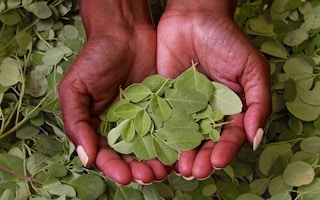In Bangladesh, farmers are increasingly tapping into a growing global market for moringa, a tree prized for its nutritional value and potential as a climate solution.
The fast-growing, drought-resistant moringa (Moringa oleifera) tree is indigenous to South Asian nations such as India, Pakistan, Bangladesh and Afghanistan and widely cultivated in tropical and subtropical countries.
As both the leaves and the fruits of the moringa tree are rich in nutrients, with so many minerals combining to provide both immunity-boosting and life-sustaining nutrients, researchers refer to moringa leaves as highly beneficial to the human body.
A Bangladeshi entrepreneur has been working to create a social movement and entrepreneurship in moringa cultivation and marketing since 2017 and has set up producer groups for community farming, contract farming and homestead cultivation of moringa in 20 districts of Bangladesh.
“I have been trying to make people understand the importance of moringa cultivation and its economic and health benefits since 2004. Since in 2017, I have engaged myself specifically on Moringa and product development by using different parts of the plant, and finally in 2022, I formed a company named GT Moringa Ltd. with the support of investors,” said Rajib Parvez Raju, the chief executive of GT Moringa Ltd.
About 5,000 farmers in 20 districts from different parts of the country have planted moringa plants, and all of them are selling the leaves, which are used to produce a range of products, including moringa powder, moringa cookies and other beauty products, based on market demand, he added.
The initial motivation for the farmers to participate was to use fallow land to earn extra money from the plant.
Mohammad Azim, a farmer from the frequently drought-prone area of Kushtia district, said, “I have been cultivating moringa trees in my 2.5 acres of arable land for the last five years. From there, I am now getting 400,000 taka (US$3,600) annually as profit.
“
I have been trying to make people understand the importance of moringa cultivation and its economic and health benefits since 2004. Since in 2017, I have engaged myself specifically on Moringa and product development by using different parts of the plant.
Rajib Parvez Raju, chief executive, GT Moringa Ltd
As the local demand for moringa products in Bangladesh is comparatively less than in most other countries, GT Moringa aims for its products to reach areas with higher market demand globally.
Regarding this, Rajib Parvez Raju told the Mongabay that by using vast amounts of fallow land and ensuring the quality and variety of products, the target is to capture a significant stake in the global market.
Health awareness and the growing global moringa market
According to a study, all parts of the moringa plant, including the leaves, pods, seeds, roots and flowers, have a nutritional profile rich in high biological value proteins, vitamins A and C, antioxidants, omega-3 fatty acids, and minerals such as calcium, iron, potassium and phosphorus. As a result, they can be used in various industrial sectors, including pharmaceutical, cosmetic, human food, animal feed and water treatment.
Data show that the global market size of moringa products was about US$9.5 billion in 2022. It is projected to grow to around US$18.2 billion by 2030, with a growth rate of 8.5 per cent annually, thanks to growing health awareness among people across the globe.
According to the World Health Organization, 422 million people, mostly from low- and middle-income countries, are suffering from diabetes. In the case of Type 2 diabetics, the human body produces inadequate insulin. The chlorogenic acid in moringa helps to balance the sugar level in the human body more effectively and add insulin naturally. Considering the health benefits, the demand for moringa-based products is rising in Europe, North America and South America.
Based on demand, producers offer different types of products, including moringa leaf, moringa oil, moringa fruits, and moringa powder, which can be consumed as soups, curries, stews and salads.
Moringa as an adaptation tool in changing climatic pattern
Moringa trees can aid in the fight against desertification since they thrive quickly in arid climates. Because of its extensive taproot, moringa can withstand dry spells. Additionally, moringa can be grown in regions that experience severe soil erosion due to prolonged dry spells and strong winds.
According to the Global Climate Risk Index, Bangladesh has been the seventh-most-affected country worldwide by extreme weather occurrences during the past 20 years.
Additionally, a changing climate has worsened drought and food insecurity in the drought-prone northern region due to shifting rainfall patterns and river water diversion across the border in India.
According to the Bangladesh Ministry of Agriculture, of 8.8 million hectares (21.7 million acres) of arable land, 0.4 million hectares (988,000 acres) are unused, for various reasons including drought and salinity.
Researchers also suggest that moringa cultivation could be a part of smart agriculture as climatic patterns change, as the plant can tolerate extreme heat and cold.
Md. Hamidur Rahman, former director-general of the Bangladesh Agricultural Extension, said, among other climatic solutions, planting more moringa in fallow lands could help the country use the lands and ensure economic benefits for rural communities.
Moringa can also serve as a backup, in case of conventional crop failure — including cereals —due to the changing climate and other anthropogenic conditions. Moringa offers people both health and financial benefits, said Pavel Partha, director of the Bangladesh Resource Center for Indigenous Knowledge (BARCIK).
This story was published with permission from Mongabay.com.










